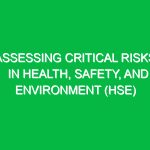Introduction
Hello, team! Today, we gather for an important toolbox talk focused on a pressing issue affecting workplaces across various industries—Opioid Abuse. This talk aims to provide you with essential insights, practical guidelines, and actionable strategies to address Opioid Abuse within the Health, Safety, and Environment (HSE) framework. Understanding this topic is crucial for maintaining a safe and healthy work environment. Let’s dive in!
Understanding Opioid Abuse
Opioid Abuse refers to the misuse of prescription or illicit opioids leading to addiction, health complications, and hazardous situations, particularly in workplaces. These substances include medications such as oxycodone, hydrocodone, and morphine, as well as illegal drugs like heroin. The crisis surrounding Opioid Abuse has reached alarming levels, impacting not just individual health but also workplace productivity and Safety.
The Scope of the Problem
According to the National Institute on Drug Abuse (NIDA), more than 10 million people misused prescription opioids in 2019 alone. This staggering statistic highlights the necessity for us to confront Opioid Abuse head-on. In our work environment, the implications of Opioid Abuse can manifest in various ways, from decreased alertness to an increase in accidents and injuries on the job.
Why Opioid Abuse Matters in HSE
As employees, your Safety and well-being are our top priorities. Understanding how Opioid Abuse can impact your work environment is essential for several reasons:
- Safety Risks: Impaired judgment and coordination due to Opioid Abuse can lead to accidents and injuries, putting yourself and your colleagues at risk.
- Productivity Loss: Absenteeism and reduced work performance due to substance abuse can affect team morale and project timelines.
- Legal Consequences: Employers can face legal repercussions if they do not address Opioid Abuse in the workplace, including liability for accidents caused by impaired employees.
Identifying Potential Hazards
Opioid Abuse can introduce a range of Hazards in our workplace. Here are some key risks to be aware of:
- Physical Hazards: Impaired employees may struggle with tasks requiring physical coordination or attention to detail, increasing the likelihood of accidents.
- Mental Hazards: The cognitive Effects of opioids can lead to poor decision-making, further heightening safety risks.
- Social Hazards: Stigmatization and lack of support can make it harder for colleagues struggling with addiction to seek help.
Best Practices for Preventing Opioid Abuse
Addressing Opioid Abuse in the workplace requires a proactive approach. Here are some Best Practices to implement:
1. Education and Awareness
Informing employees about the dangers of Opioid Abuse is crucial. Regular Training sessions can help staff recognize the signs of misuse and understand the implications of substance abuse on safety and productivity.
2. Promote Open Communication
Create an environment where employees feel comfortable discussing their concerns about Opioid Abuse. Encourage open dialogue, and make it clear that seeking help is a sign of strength, not weakness.
3. Implement a Drug-Free Workplace Policy
Establish a clear drug-free workplace policy that outlines expectations regarding substance use, including opioids. Ensure that all employees understand the rules and the consequences of violating them.
4. Offer Support Programs
Consider providing access to Employee Assistance Programs (EAPs) that offer counseling and support for those struggling with substance abuse. These programs can be vital for employees seeking help without fear of stigma.
5. Regular Monitoring and Evaluation
Continuously assess the effectiveness of your policies and practices related to Opioid Abuse. Gather feedback from employees and make adjustments as necessary to ensure a safe work environment.
Real-Life Scenarios
To emphasize the importance of our discussion, let’s consider a couple of hypothetical scenarios:
Scenario 1: The Impaired Worker
Imagine a scenario where an employee, John, is prescribed opioids for chronic pain. Unbeknownst to his supervisor, John is struggling with the medication’s side effects, which significantly impair his ability to operate heavy machinery. One day, while attempting to lift a heavy load, John misjudges his strength, resulting in a workplace accident. This incident could have been avoided if John had received support and education about the risks associated with Opioid Abuse.
Scenario 2: The Team Environment
In another situation, Sarah, a team member, notices changes in her colleague’s behavior that suggest potential substance abuse. Rather than addressing it directly, Sarah decides to talk to her manager about her concerns. The manager recognizes the importance of addressing Opioid Abuse in their team and initiates a conversation with the employee, providing resources and support. This proactive approach fosters a supportive work culture and can lead to positive outcomes.
Compliance and Regulations
Understanding relevant regulations and Standards is crucial in tackling Opioid Abuse effectively. Here are some key points to consider:
- OSHA Standards: The Occupational Safety and Health Administration (osha) mandates that employers ensure a safe working environment. This includes addressing substance abuse issues that could jeopardize safety.
- Drug-Free Workplace Act: This Act encourages organizations to maintain a drug-free workplace, which includes policies against Opioid Abuse.
- Company Policies: Familiarize yourself with your company’s specific policies regarding substance use and the resources available for employees.
Conclusion
In conclusion, confronting Opioid Abuse is a collective effort that requires awareness, communication, and proactive measures within our workplace. By understanding the risks, implementing Best Practices, and fostering a supportive environment, we can mitigate the impact of Opioid Abuse on our health and safety. Thank you for your attention today, and for your commitment to maintaining a safe and healthy work environment. Remember, if you or someone you know is struggling with Opioid Abuse, don’t hesitate to seek help—together, we can create a safer workplace for everyone.


